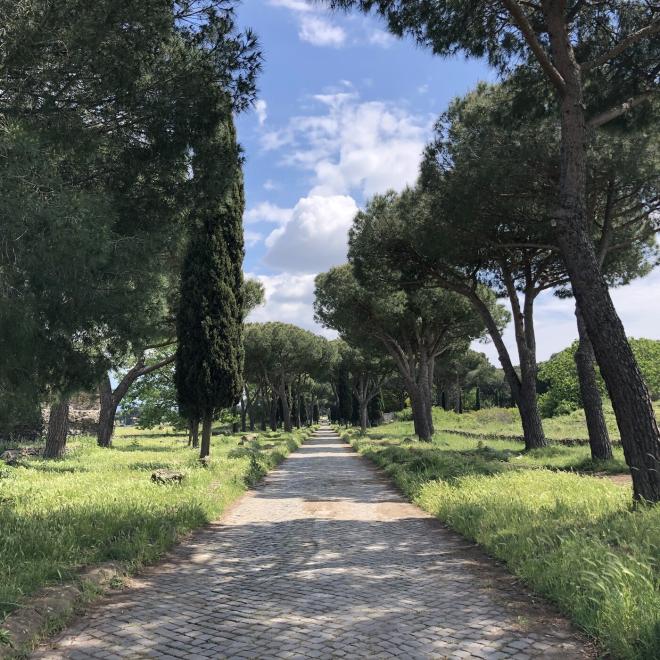NSO Music Director Gianandrea Noseda is the perfect guide for a musical tour of the Eternal City.* “To put together in the same program the three Roman tone poems, Fountains, Pines and Roman Festivals by Respighi,” he said, “is particularly meaningful because for the ones who already visited Rome it will be something to relive, for someone who doesn’t have this experience it probably will create the curiosity to see what kind of city could inspire a composer to write such music, and for someone who doesn’t even have the plan to go to Rome, to experience the Eternal City outside Italy on the stage of the concert hall at the Kennedy Center.”
You know, Maestro Noseda is absolutely right. Just reading Respighi’s own descriptions of his Roman Trilogy which you’ll see below, makes me want to hop on a plane to see these beautiful scenes for myself.
Looking ahead to the upcoming NSO season, Director of Artistic Planning Nigel Boon told me that the “First 2 weeks kinda feature music from Gianandrea’s heritage [in Italy and Russia--the first week was a celebration of Rachmaninoff at 150] We’re doing all 3 (Respighi) Roman tone poems in one program which doesn’t happen a lot. You’ll hear one or two, but all three is quite rare. It’s a big evening for the brass of course, they’ve got lots to do.”
In fact, Ottorino Respighi’s experience mirrors Gianandrea Noseda’s in that he too spent time in Russia, first as an orchestral viola player, and then studying with that master of orchestral color, Rimsky-Korsakov, an experience which is gloriously reflected in the Roman Trilogy.

You could call The Fountains of Rome Respighi’s breakthrough piece. He had settled in Rome in 1913, to teach composition at the famed St. Cecilia Academy. He wrote that the city’s “marvelous fountains...and umbrella-like pines that appear in every part of the horizon...spoke to my imagination above all.” It was here that he was inspired to write this 4-part tone poem, depicting Rome’s fountains at various times of day. The Fountain of the Valle Giulia at dawn. The Triton Fountain in the Morning. The Trevi Fountain at Midday. The Villa Medici Fountain at Sunset.
The 1917 premiere in Rome was something of a flop. But the following year, Toscanini conducted the work in Milan, and Fountains was a hit and became a huge international success. Respighi then wrote the sequel, the Pines of Rome in 1917. It’s sad to note that the iconic umbrella pine trees of Rome that Respighi so loved are being decimated by an invasive bug known as the pine tortoise scale, as a recent New York Times article described:
“Celebrated in music and art, and admired by the ancient Romans, Rome’s signature umbrella pine trees are as much a part of the city’s identity as its human-made landmarks.”
Our first stop is the pine forest at the Villa Borghese, where children are playing, singing, and dancing and “mimicking marching soldiers and battles...twittering and shrieking like swallows...suddenly the scene changes.”
To “the pines which overhang the entrance of a catacomb. From the depths rises a chant, which echoes solemnly, like a hymn, and is then mysteriously silenced.”
Then, “there is a thrill in the air...the full moon reveals the profile of the pines of the Janiculum Hill. A nightingale sings.” Famously, Respighi asked for a special recording of a bird sound effect to be played here... a first!
“Misty dawn on the Appian Way. The tragic country is guarded by solitary pines. The rhythm of unending steps. Trumpets blare, and the army of the Consul bursts forth in the grandeur of a newly risen sun toward the Sacred Way, mounting in triumph the Capitoline Hill.”
The third installment in the Roman Trilogy, Feste Romane was premiered at Carnegie Hall in 1929 with Toscanini conducting the New York Philharmonic.
It’s impossible to visit Rome’s Coliseum without feeling haunted by images of antiquity...of gladiators fighting to the death, of martyrs facing lions and the roaring bloodthirsty crowds. Respighi evokes it all in the first movement of Feste Romane, Circus Maximus.
In the next movement, Jubilee, medieval pilgrims march to Rome the strains of the German Easter Hymn.
L’ottobrata, or October Harvest is a festival celebrating food, fun and love, to the accompaniment of hunting horns and mandolins.
The final movement is La Befana, or Eve of Epiphany. Imagine a crowded carnival in the Piazza Navona, bursting with singing and dancing. A barrel organ entertains the revelers while a trombone embodies a drunken partygoer who communed a little too much with Bacchus, the Roman God of wine.
This marathon celebration of the Eternal City takes place at the Kennedy Center Concert Hall, Thursday through Saturday, October 5-7.
*Here is an update from the National Symphony Orchestra (October 3, 2023):
NSO Music Director Gianandrea Noseda has withdrawn from this week’s program due to testing positive for COVID-19. “I was looking forward to leading this very special program,” Noseda said. “It was wonderful to be back with the artists of the National Symphony Orchestra and our enthusiastic audience for the Opening Night Gala and first week of subscription concerts. I’m looking forward to being back with everyone very soon.”
Music Director of the Detroit Symphony Orchestra Jader Bignamini has graciously agreed conduct the concerts, marking his NSO debut. The program—Respighi’s Fontane di Roma, Pini di Roma, and Feste Romane—will remain the same.
PBS PASSPORT
Stream tens of thousands of hours of your PBS and local favorites with WETA+ and PBS Passport whenever and wherever you want. Catch up on a single episode or binge-watch full seasons before they air on TV.
